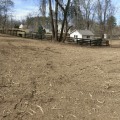Forestry mulching has gained popularity as an efficient and eco-friendly method of land clearing, but its benefits extend far beyond aesthetics and site preparation. One of the most significant advantages of forestry mulching is its positive impact on soil health. By transforming unwanted vegetation into nutrient-rich mulch, this method supports soil fertility, prevents erosion, and promotes biodiversity. However, understanding how and when to use forestry mulching is key to maximizing its benefits. Below, we’ll explore the relationship between forestry mulching and soil health, along with its practical applications and potential limitations.
How Forestry Mulching Works
Forestry mulching involves using a specialized machine, often called a mulcher or masticator, to shred trees, brush, and other vegetation into a fine layer of mulch. This process converts organic matter into small pieces that are left on the ground, creating a protective layer over the soil. Unlike traditional clearing methods that involve hauling away debris, mulching allows the material to decompose naturally on-site.
The simplicity of forestry mulching makes it an appealing option for landowners and professionals alike. It’s commonly used in applications like wildfire prevention, site preparation, and invasive species management. Additionally, it’s a cost-effective solution for improving soil health without the need for chemical fertilizers or extensive labor.
Benefits of Forestry Mulching for Soil
Improves Soil Fertility
One of the primary benefits of forestry mulching is its ability to enhance soil fertility. As the mulched material breaks down, it releases essential nutrients, such as nitrogen, phosphorus, and potassium, into the soil. This natural process enriches the soil and supports the growth of healthy vegetation, reducing the need for synthetic fertilizers.
The decomposing mulch also fosters a thriving ecosystem of microorganisms, fungi, and earthworms, which play a vital role in nutrient cycling. This enhanced biological activity creates a balanced and fertile environment for plants to flourish.
Reduces Soil Erosion
Exposed soil is highly vulnerable to erosion caused by wind and water. Forestry mulching creates a protective barrier that shields the soil from these forces, helping to retain its structure and prevent valuable topsoil from being washed away. This is especially important on slopes or areas prone to heavy rainfall, where erosion can quickly degrade the land.
The mulch layer also absorbs and slows down the flow of water, allowing it to infiltrate the soil more effectively. Improved water retention helps maintain soil moisture levels, reducing the need for irrigation and supporting plant growth.
Enhances Soil Structure
Forestry mulching improves soil structure by adding organic matter to the ground. As the mulch decomposes, it binds soil particles together, creating a crumbly texture that enhances aeration and drainage. This improved structure allows roots to penetrate more easily and access the nutrients and water they need to grow.
Suppresses Weeds
The thick layer of mulch created during forestry mulching acts as a natural weed suppressant. By blocking sunlight, it inhibits the germination of weed seeds, reducing competition for nutrients and water. This helps native plants establish themselves and thrive, promoting biodiversity and ecological balance.
Supports Sustainable Land Management
Forestry mulching is a sustainable land management practice that aligns with eco-friendly goals. By recycling organic material directly into the soil, it reduces the need for landfill disposal and minimizes carbon emissions associated with transporting debris. This method also avoids the use of chemicals or synthetic inputs, making it an environmentally responsible choice for soil improvement.
Practical Applications of Forestry Mulching
Forestry mulching is widely used in agriculture, landscaping, and conservation projects. It’s particularly beneficial for preparing sites for planting, restoring degraded lands, and managing invasive species. Landowners seeking professional assistance can benefit from services like tree service, which often include forestry mulching as part of their offerings for land clearing and soil improvement.
For farmers, forestry mulching can rejuvenate pastures and create optimal conditions for crop growth. In urban and suburban settings, it’s an effective way to clear overgrown lots or manage stormwater runoff while enhancing soil quality.
Potential Limitations and Considerations
While forestry mulching offers numerous benefits, there are some limitations to consider. The effectiveness of mulching depends on the type of vegetation being cleared and the desired outcome. For example, mulching invasive species requires careful monitoring to prevent regrowth, as some plants can resprout from root fragments left in the soil.
It’s also important to apply the right thickness of mulch. While a layer of mulch helps retain moisture and suppress weeds, an overly thick layer can create a barrier that hinders water and air infiltration. Consulting with professionals or arborists ensures the proper application of forestry mulching for optimal results.
Conclusion
Forestry mulching is an excellent practice for improving soil health and promoting sustainable land management. By enriching the soil with organic matter, reducing erosion, and suppressing weeds, it creates an ideal environment for plants to thrive. Whether you’re preparing land for agricultural use, enhancing your landscape, or restoring degraded areas, forestry mulching offers a practical and eco-friendly solution. Partnering with experts in tree service ensures that forestry mulching is performed effectively, maximizing its benefits for both the soil and the surrounding ecosystem.



